Users these days demand top-notch performance and security from the applications installed on their devices. Hence, ensuring the highest standard of software quality isn’t optional anymore. It’s a necessity.
Organizations across various industries spend tons and tons of resources to make the best application. They rely on test management tools to ease their software quality assurance process. Using these tools helps organizations improve collaboration and accelerate delivery time.
So, whether you’re a part of a small startup or a large enterprise, selecting the right test management tool is important. As it can majorly affect your testing efficiency and software quality.
To help you out in the tool selection process, we have compiled a list of the best test management tools. They are able to change the game single-handedly in 2025. Their features stand out. Usability is great. Integrations are offered. And the overall value of our selected tools is adequate.
Why Invest in a Test Management Tool
Before starting with the list, let us tell you why a dedicated test management tool is a great resource in QA workflows. The following are some reasons.
- Centralized Testing Activities: Allows for managing test cases, along with plans, runs and defects all in one place.
- Improved Collaboration: Makes it easy to carry out communication between QA teams and developers. Stakeholders are kept in the loop as well.
- Traceability & Reporting: Testing progress and quality metrics are easily tracked. There are customizable dashboards for each user.
- Integration with Automation: QA teams can easily connect with automation frameworks. As well as CI/CD pipelines.
- Scalability: Testing efforts across multiple projects and teams are supported.
However, the thing is that in 2025, organizations demand even more than this from test management tools. They want flexibility, AI-driven insights, cloud-based accessibility and integrations with other DevOps tools. These are the standard expectations.
The tools that our list comprises fulfill all these needs.
Best Test Management Tools in 2025
Here are our picks for the 10 best test management platforms.
1. Kualitee

Kualitee is the first name that comes to mind when thinking of a test management tool. And that’s obvious because it shines as a complete tool that’s designed to help QA teams manage the entire testing lifecycle with ease.
The interface is user-friendly. QA and development teams can design as well as execute and monitor tests collaboratively. On top of that, Kualitee offers extensive integration options with popular CI/CD tools and automation frameworks. Selenium, Jenkins, and Jira are some tools it can integrate with.
There are also real-time analytics dashboards. These provide users with actionable insights. Stakeholders can make data-driven decisions quickly with this feature.
Furthermore, Kualitee supports both agile and traditional methodologies. This makes it ideal for a wide range of project sizes and industries.
The cherry on top is that Kualitee has its own AI assistant named Hootie. It allows automated test case generation through the requirements of users or by analyzing screenshots of UI elements. They have recently added automated test case execution to their features as well.
Prominent Features of Kualitee:
- End-to-end test case management and execution.
- Built-in AI assistant called Hootie, which can generate test cases and execute them.
- Defect tracking with complete traceability.
- Support for agile, waterfall, as well as hybrid methodologies.
- Cloud-based and on-premise deployment options.
- Personalized dashboards for each user.
Pricing:
Kualitee offers a 14-day free trial. After that, it’s currently $12 per user/month. The annual package costs $108 per user. There’s also a viewer license that’s just $7/month (or $84/year).
2. Zephyr by SmartBear
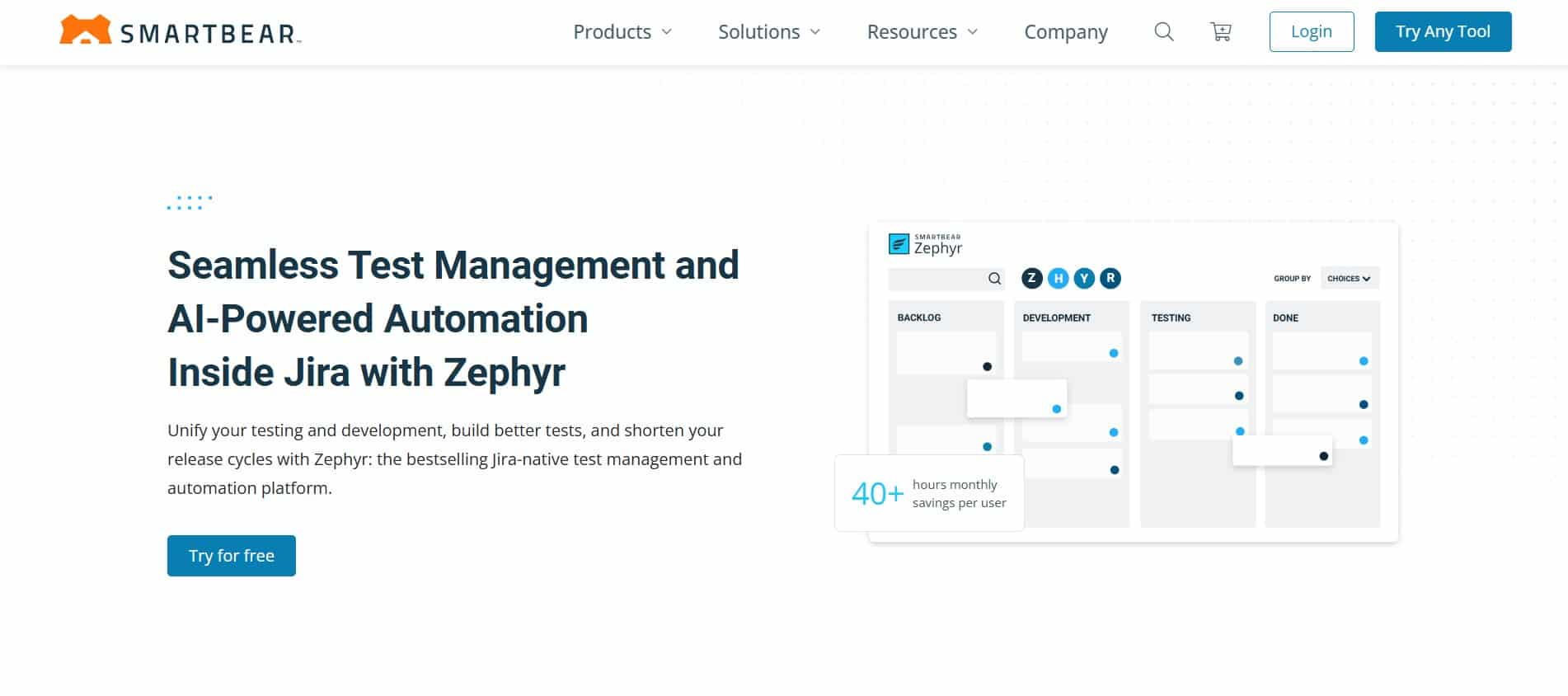
Zephyr by SmartBear is one of the most well-established test management tools out there. It works best in enterprises that make use of Jira for project management. That’s because Zephyr integrates natively with Jira. It enables testers to create and organize test cases directly within the Jira environment.
This integration reduces tool switching. Leading to transparency across teams. Zephyr supports both manual and automated testing, which is great. Advanced reporting features are also offered. Teams can easily access traceability matrices and test coverage charts.
The enterprise-grade scalability of Zephyr ensures it can accommodate large volumes of test cases and users.
Prominent Features of Zephyr by SmartBear:
- Native Jira integration for smooth workflow.
- Support for manual and automated testing.
- Advanced reporting and traceability matrices.
- Scalable for enterprise and distributed teams.
- Real-time collaboration and sprint-aligned processes.
- Cloud and on-premise deployment.
Pricing:
Zephyr offers two subscription tiers: Standard and Advanced.
The standard tier costs $10 per user/month, while the advanced tier costs $30 per user/month. When it comes to annual subscriptions, they are $100 per user/year for the standard and $300 per user/year for the advanced tier. Enterprise and on-premises solutions are priced via custom quotes.
3. TestRail

TestRail is widely appreciated for its clean and intuitive user interface. Along with its powerful test case management capabilities.
This tool allows QA teams to organize their tests in comprehensive plans and run them with ease. TestRail helps QA managers maintain control over testing activities. It lets them track the progress and generate reports that can be shared with the stakeholders.
The tool’s flexibility caters to every team. It doesn’t matter if they are practicing waterfall, agile or hybrid development methodologies.
Also, TestRail integrates easily with other issue trackers and automation tools. This helps in coordinating manual and automated test executions. When it comes to exploratory testing, it is supported as well. Configurable permissions are provided to QA managers so they can tailor access levels for different team members.
Prominent Features of TestRail:
- Organize test cases, milestones and test runs flexibly.
- Detailed and customizable reporting for stakeholders.
- Easy integration with Jira, Bugzilla, Selenium and CI tools.
- Support for exploratory and manual testing.
- Role-based access along with permission management.
Pricing:
TestRail has a professional as well as an enterprise plan.
The professional plan starts at $40 per seat/month and the enterprise plan is for $76 per seat/month. There are also annual plans that cost $456 for 12 months, for 1 user when it comes to the professional tier, and $912 for 12 months, for 1 user when it comes to the enterprise tier.
4. qTest by Tricentis
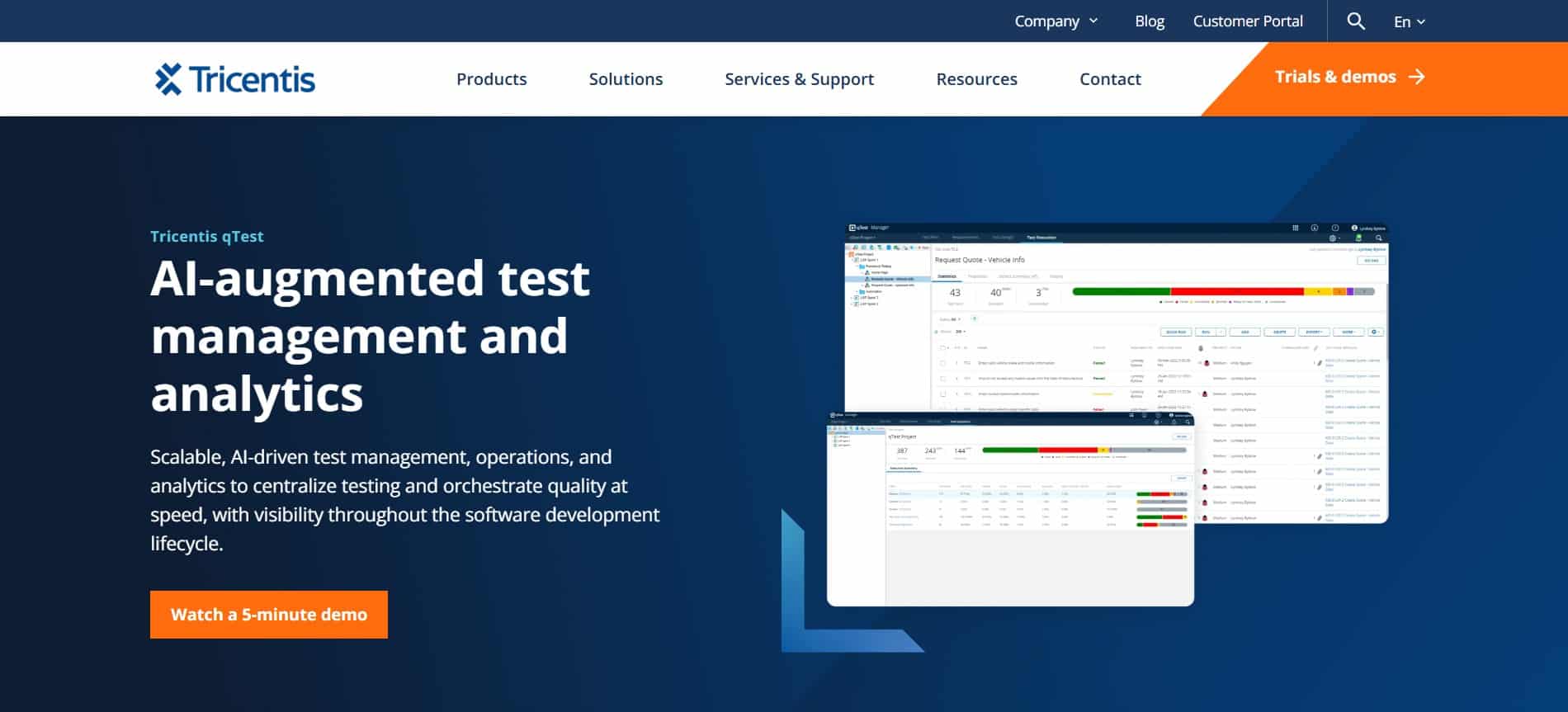
qTest by Tricentis is an enterprise-ready test management solution. It’s great in addressing the needs of large-scale software development and testing teams. Especially the ones who employ continuous testing and DevOps.
The tool offers comprehensive test case management. Defect tracking and risk management capabilities are also available. qTest’s open APIs allow it to integrate with over 40 popular ALM and automation tools. For example, Jira, Jenkins, Selenium, GitLab, etc.
The real-time dashboards provided by qTest offer KPI visibility. This helps teams identify risks early and improve test coverage. With support for agile workflows and CI/CD pipelines. Along with automated testing, qTest helps accelerate delivery cycles. All while maintaining high-quality standards.
Prominent Features of qTest by Tricentis:
- Enterprise-grade test management with risk-based testing.
- Integration with over 40 ALM and automation tools.
- Real-time KPI dashboards and analytics.
- Agile and DevOps-friendly workflows.
- Automated test result aggregation and reporting.
Pricing:
qTest offers a 14-day free trial. Pricing can be requested from their team or by contacting them through their website.
5. PractiTest
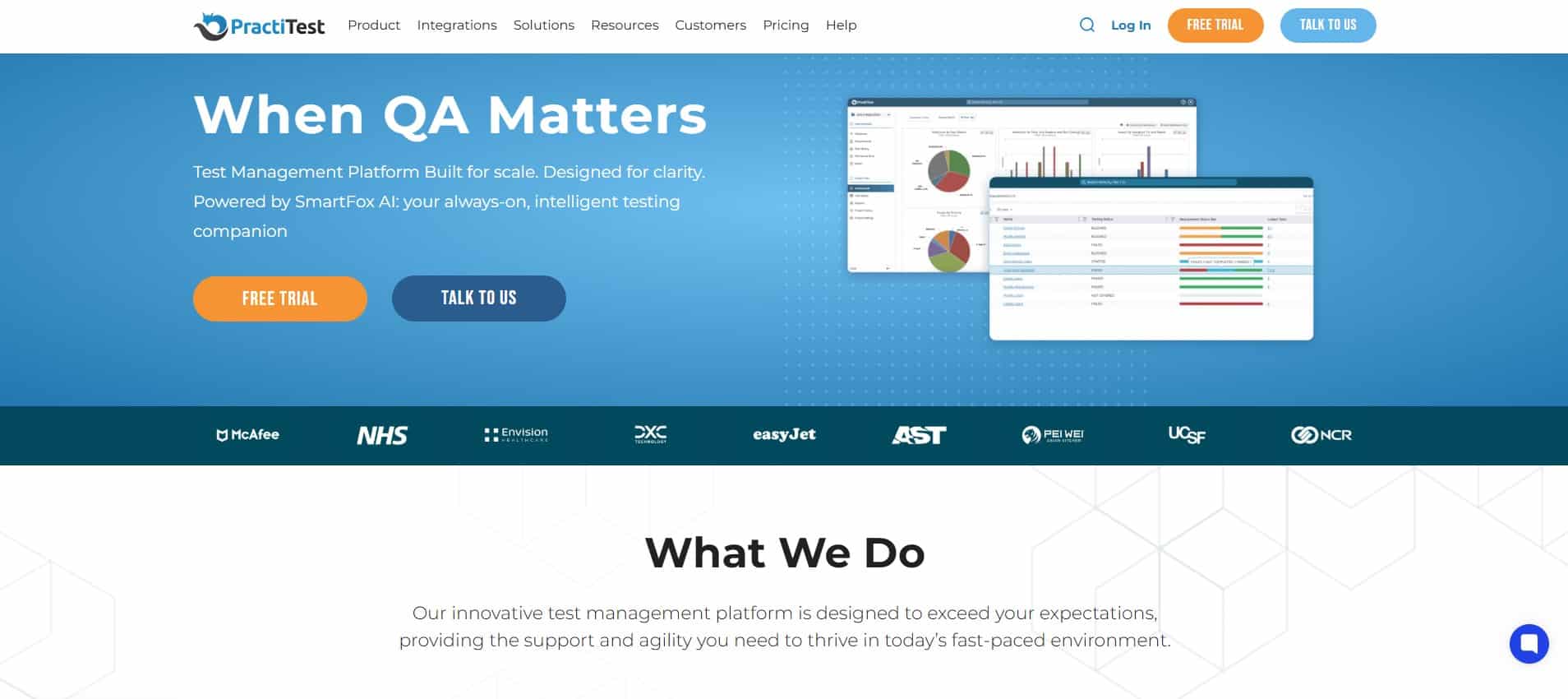
PractiTest allows mixing traditional test management with advanced business intelligence capabilities.
The tool offers a unique perspective on software quality. This test management tool provides end-to-end visibility by linking requirements. Along with tests and defects in one platform.
This traceability is important for compliance-heavy industries and teams focused on quality alignment with business goals. PractiTest also supports integrations with automation frameworks such as Selenium and CI tools. It allows automated test results to flow into test cycles.
The custom dashboards enable diverse teams to monitor progress. Quality can be analyzed from their unique viewpoints. Which, in turn, fosters collaboration and transparency.
Prominent Features of PractiTest:
- Full traceability between requirements, tests and defects.
- Customizable dashboards for stakeholders at all levels.
- Integration with automation frameworks and CI/CD tools.
- Business intelligence and risk assessment features.
- Supports manual and automated testing workflows.
Pricing:
PractiTest offers a 14-day free trial. Once that’s over, it charges $54 per user/month. There’s also a yearly plan as well as a customized corporate plan.
6. TestLink
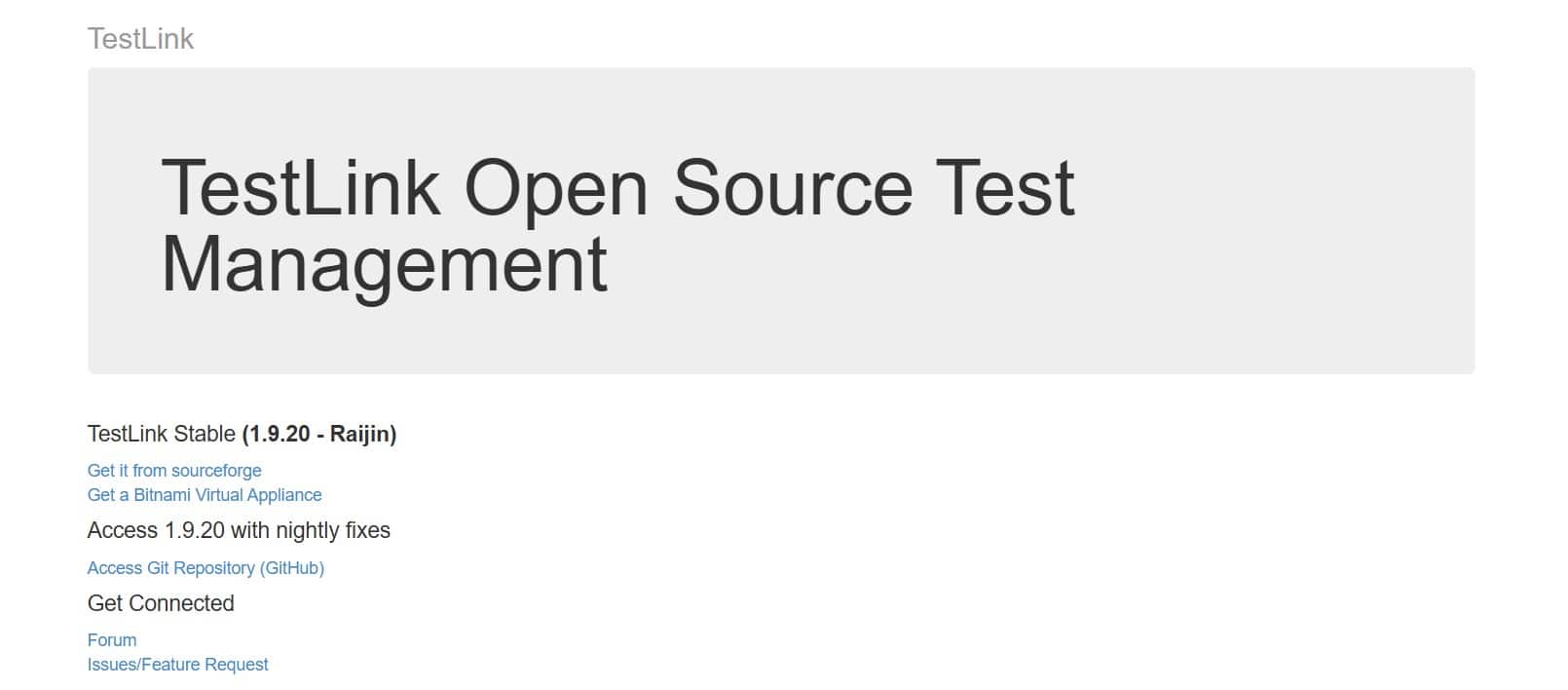
For teams that are seeking a cost-effective and open-source solution, TestLink can be a good choice.
When compared to other tools, TestLink is more basic. But still, it covers all the important test management tool functions. Such as test case creation, execution tracking and reporting.
Not just that, TestLink supports integration with various defect tracking systems as well. Namely Bugzilla, Mantis and Jira, among others. This helps teams connect testing activities with development workflows.
While TestLink’s user interface is dated, the platform still has a strong community. Its web-based interface supports remote accessibility too. The platform can work particularly well for small to mid-size teams. Or for those who are experimenting with test management tools for the first time.
Prominent Features of TestLink:
- Open-source and free to use.
- Test case creation and execution. Reporting tools are there as well.
- Web-based access with remote usability.
- Integration with multiple bug tracking systems.
- Community support and flexibility.
Pricing:
TestLink is totally free because it’s an open-source tool. There are no licensing fees either.
7. Xray for Jira
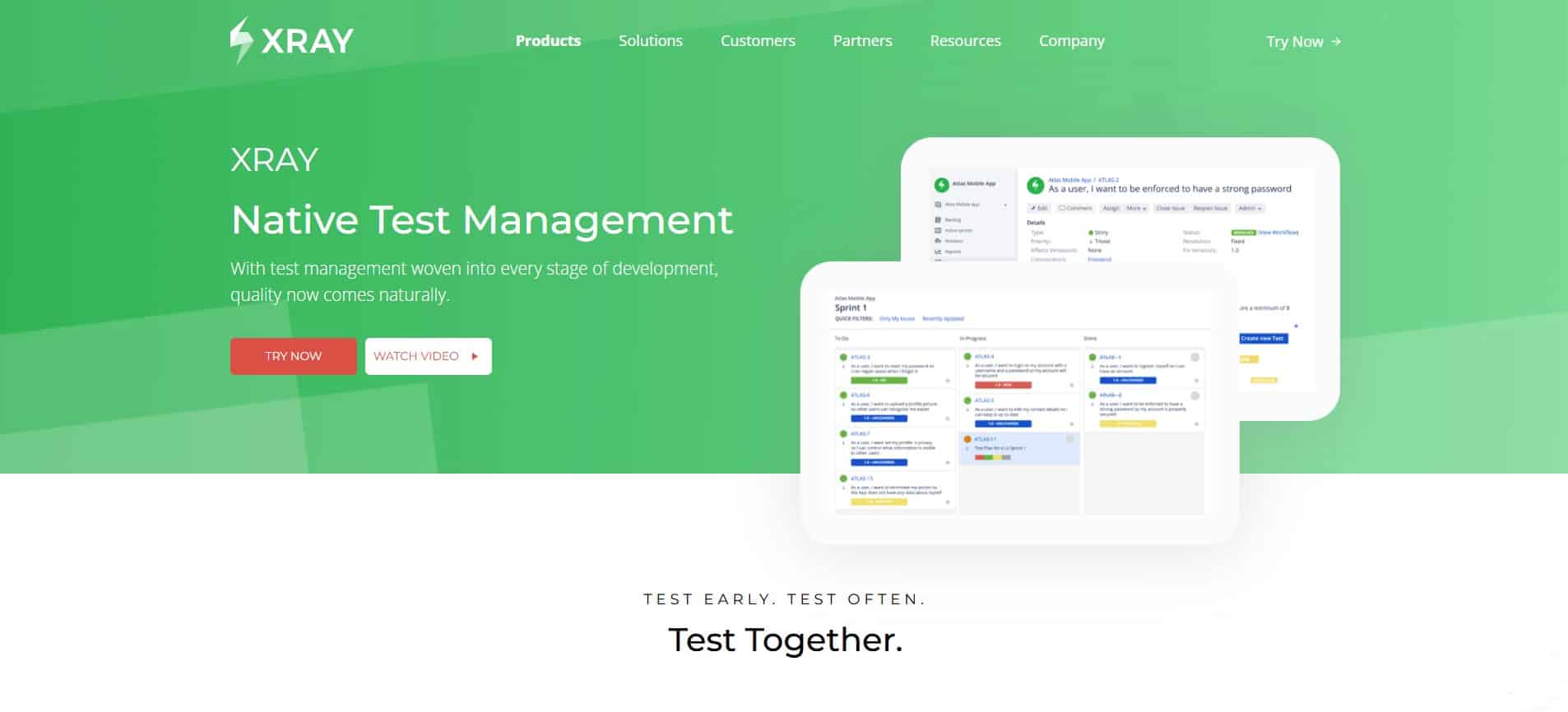
Xray is a Jira-native test management tool that treats tests as Jira issues. It allows teams who are already using Atlassian products to manage their entire quality lifecycle. All without even leaving Jira.
It supports different test types. Which include manual, automated and BDD (Behavior-Driven Deployment) tests. This makes it a good option for diverse workflows. Xray also allows full traceability between requirements and defects, improving quality visibility for stakeholders.
The reporting features of Xray include test coverage and execution progress. Along with traceability matrices, which are directly accessible within Jira dashboards. Additionally, the platform’s integration with CI/CD tools allows it to create results for automated tests. Which can then be analyzed in real time.
Prominent Features of Xray for Jira:
- Full native integration with the Jira environment.
- Supports manual, automated and BDD testing.
- Traceability between requirements, tests and defects.
- Rich, customizable reports and dashboards.
- CI/CD pipeline integration for automated testing.
Pricing:
Xray offers a free trial for 30 days for teams of all sizes. Once the trial is over, it charges $6.33 per user/month. An annual plan is also available based on the number of users.
8. TestCollab
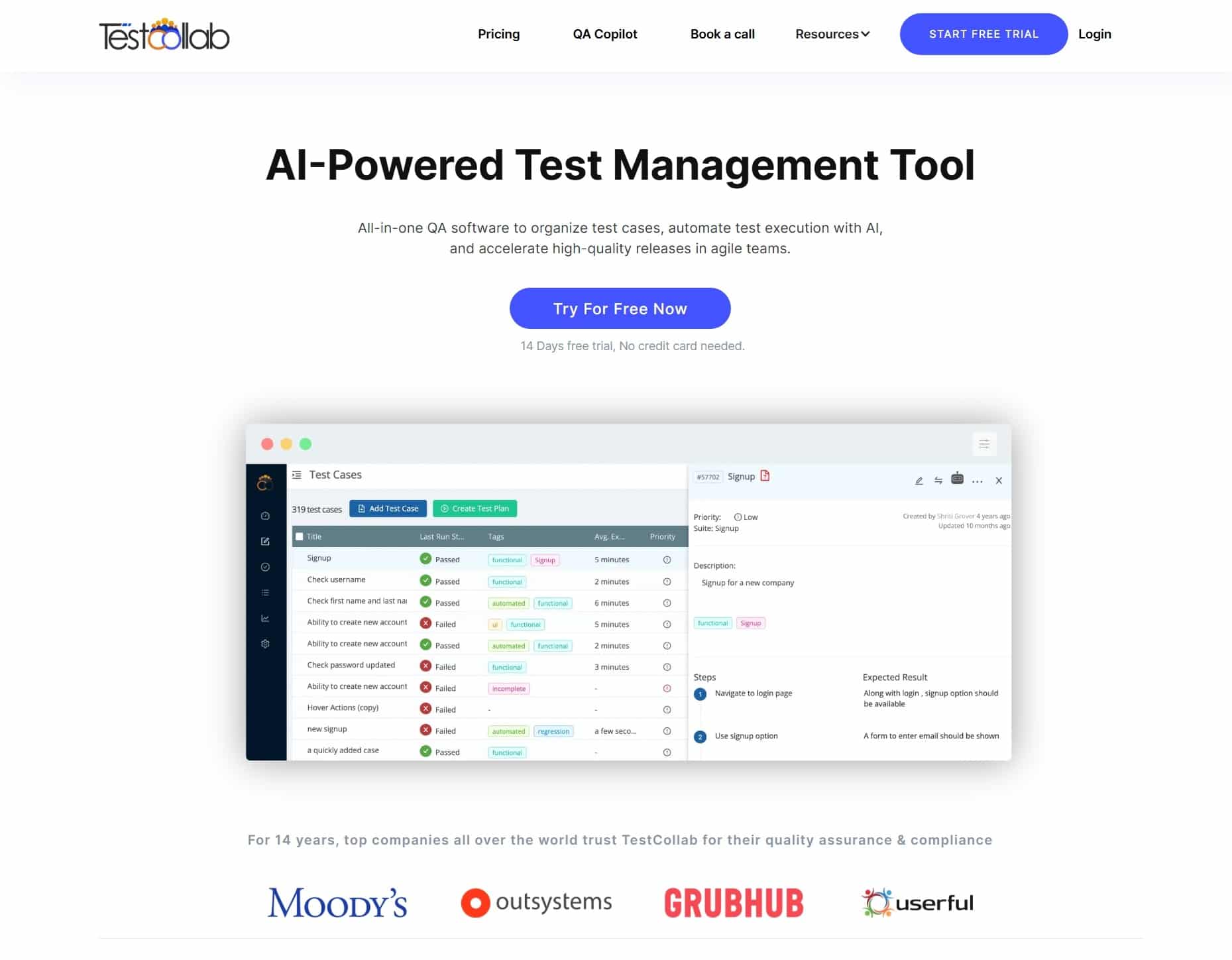
TestCollab is a versatile test management software that’s designed for teams who value collaboration tracking.
Its user-friendly design supports efficient test case management. Execution and reporting become way easier. TestCollab stands out mainly for its built-in time tracking and productivity analytics. These features help project managers assess team performance in testing activities.
The platform integrates fairly easily with tools like Jira, Slack and many automation frameworks. Due to this, information flows across the development pipeline.
The deployment is flexible as well. Both cloud-based and on-premise options are offered, making TestCollab adaptable for teams with specific compliance requirements.
Prominent Features of TestCollab:
- Test case management with collaborative features.
- Built-in tracking and productivity metrics.
- Integration with Jira, Slack, Selenium and others.
- Supports both cloud and on-premise deployment.
- Flexible reporting and dashboards.
Pricing:
TestCollab offers 3 premium tiers: Premium, Elite, and Enterprise. The Premium subscription goes for $35 or less per user/month. Elite for $45 or less per user/month. And the Enterprise tier cost can be known by contacting TestCollab.
9. QAComplete
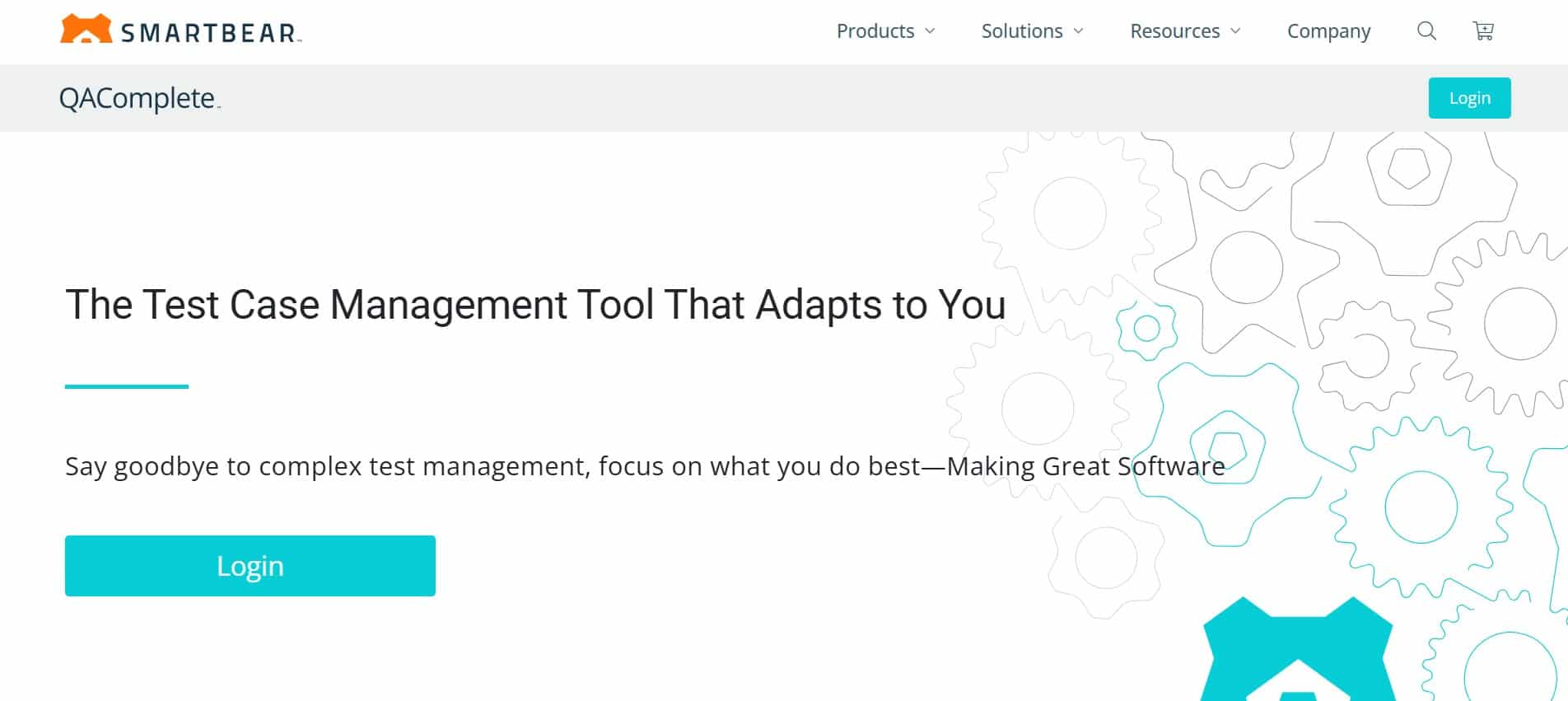
Offered by SmartBear, QAComplete is an all-in-one test management tool. It brings test management, defect tracking and requirements management all in one place.
The platform aims at teams looking for detailed traceability and control. QAComplete supports customizable dashboards and dynamic workflows to match organizational processes. It improves efficiency and consistency in testing efforts.
QAComplete can integrate with popular automation tools and CI/CD pipelines. This, in turn, allows inclusion of automated tests alongside manual ones. Features like test scheduling, automatic regression testing and impact analysis are also available. Teams can easily manage software quality and risk.
Prominent Features of QAComplete:
- Integrated test and defect management. Requirements can be managed, too.
- Customizable workflows and dashboards.
- Automation framework and CI/CD integrations.
- Test scheduling and regression testing support.
- Traceability and impact analysis capabilities.
Pricing:
QAComplete costs $999 each year per concurrent user for on-premise deployment and $599 per concurrent user for cloud deployment.
10. TestFLO for Jira
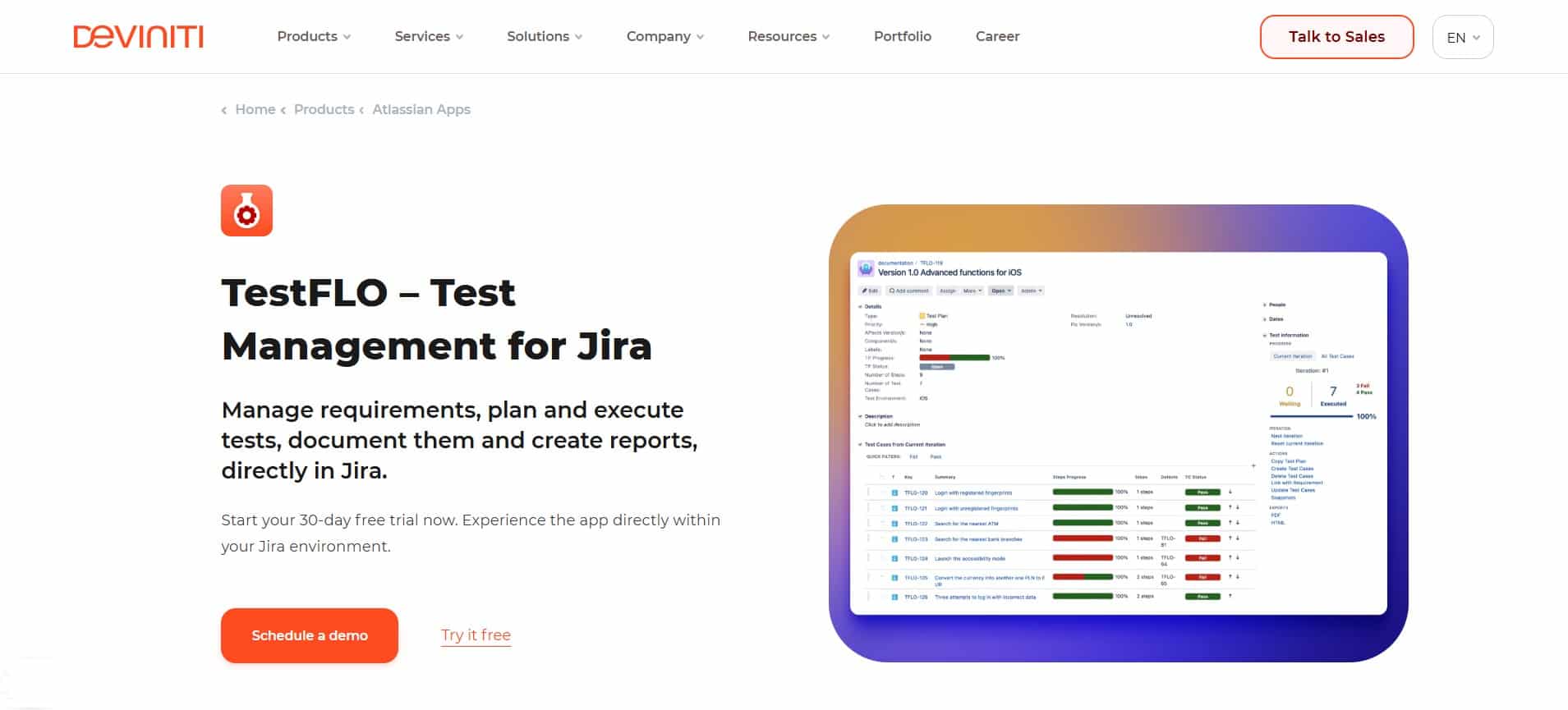
TestFLO is a feature-rich test management tool. It’s built as an app on Jira, and it leverages Jira’s flexibility while offering in-depth testing capabilities.
It simplifies test planning by representing tests and execution as Jira issues. Consequently, this enables full traceability with development tasks and defects. TestFLO supports manual, exploratory and automated testing, making it adaptable to various testing strategies.
The reporting features offered by it allow teams to generate insights into test coverage. Along with execution status and defect metrics. This helps QA teams and project managers in making informed decisions. Integrations with CI/CD pipelines are also offered by the platform to ensure that automated test results are synced.
Prominent Features of TestFLO for Jira:
- Test management fully integrated as Jira issues.
- Supports manual as well as exploratory and automated tests.
- Full traceability and linkage to defects and requirements.
- Customizable reports within Jira.
- CI/CD pipeline integration support.
Pricing:
TestFLO’s premium subscription is priced at $1,186/year for up to 50 users. The price goes up as users increase.
Factors to Consider When Choosing a Test Management Tool
Choosing the right test management tool depends on the needs of your QA team. Consider the following factor.
- Team Size and Project Complexity: Larger teams with complex projects will obviously benefit more from enterprise-grade tools like qTest or Kualitee.
- Integration Needs: Check the compatibility of your existing tools with the test management platform that you’re willing to use. Integrations with tools like Jira, Jenkins, Selenium and CI/CD platforms are usually needed.
- Automation Support: A test management platform that supports automation frameworks will streamline end-to-end testing for you.
- Ease of Use: A user-friendly interface will minimize onboarding time.
- Affordability: Evaluate the pricing models and choose a test management tool that fits your budget without compromising on the important features.
- Cloud vs On-Premise: Decide what deployment method you want, based on your security needs and infrastructure.
Comparison Table of Top Test Management Tools in 2025
The following table shows a general comparison between the aforementioned test management tools.
| Tool Name | Ideal For | Key Strengths | Integration Highlights | Deployment | Pricing Model |
| Kualitee | Agile & DevOps Teams | End-to-end management, analytics, automation | Selenium, Jenkins, Jira, Azure DevOps | Cloud & On-premise | Subscription-based |
| Zephyr | Jira Users, Enterprises | Deep Jira integration, scalability | Jira, Jenkins, automation tools | Cloud & On-premise | Subscription & Perpetual |
| TestRail | Collaborative Teams | User-friendly, reporting, exploratory testing | Jira, Bugzilla, Selenium | Cloud & On-premise | Subscription-based |
| qTest | Large Enterprises | Enterprise-grade, DevOps-ready | Jira, Jenkins, Selenium, GitLab, Azure DevOps | Cloud & On-premise | Subscription-based |
| PractiTest | Compliance & BI Focus | Business intelligence, customizable dashboards | Selenium, Jenkins, Jira | Cloud-only | Subscription-based |
| TestLink | Small/Mid Teams | Open-source, basic test management | Bugzilla, Jira, Mantis | Cloud & On-premise | Free |
| Xray | Jira Teams | Native Jira app, supports BDD, traceability | Jira, Jenkins, Bamboo | Cloud & On-premise | Subscription-based |
| TestCollab | Productivity Focus | Collaboration, time tracking | Jira, Slack, Selenium | Cloud & On-premise | Subscription-based |
| QAComplete | Traceability & Control | All-in-one, customizable workflows | Jira, Jenkins, Selenium | Cloud & On-premise | Subscription-based |
| TestFLO | Jira Users | Comprehensive Jira integration, automation | Jira, Jenkins, Bamboo | Cloud & On-premise | Subscription-based |
Conclusion
Selecting an effective test management tool is important for enhancing software quality. It makes the job of a QA team easier. Collaboration, traceability, test generation, everything gets better with a good tool.
The 10 test management tools we’ve mentioned in this article, including Kualitee, Zephyr and TestRail, are the best in the game. They include features like automation support and integrations, as well as user-friendly interfaces.
These features cater to diverse organizational needs. As the demands of software testing keep evolving, using these tools can significantly improve testing efficiency. High standards of performance and security can be met.
Lastly, businesses should carefully evaluate their specific requirements before choosing a tool from this list.
















































